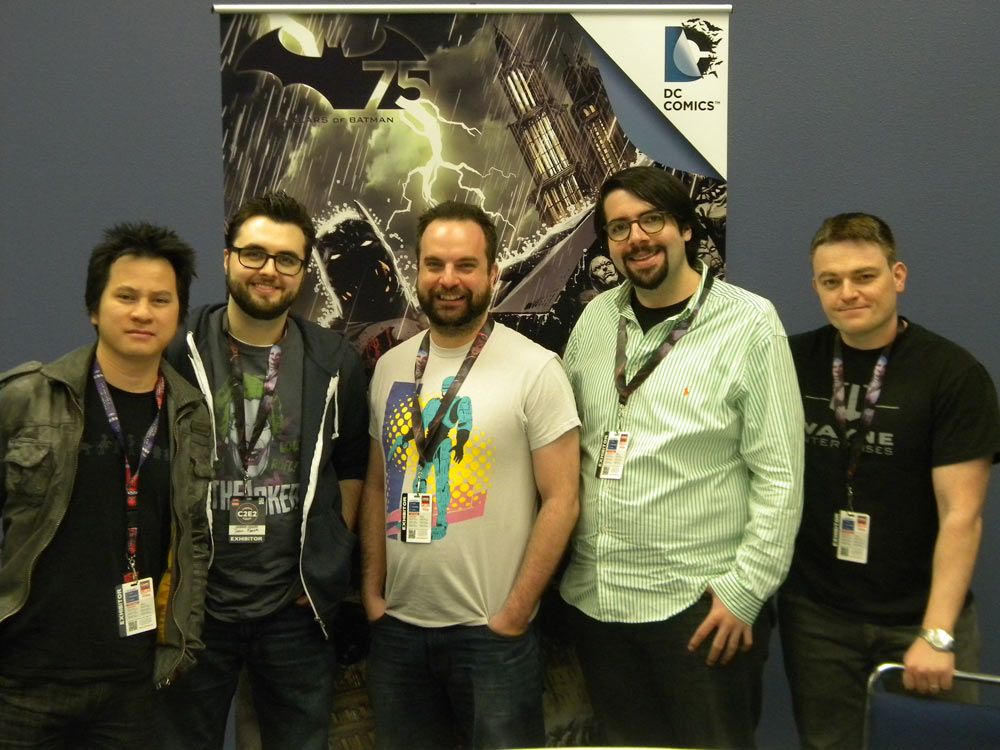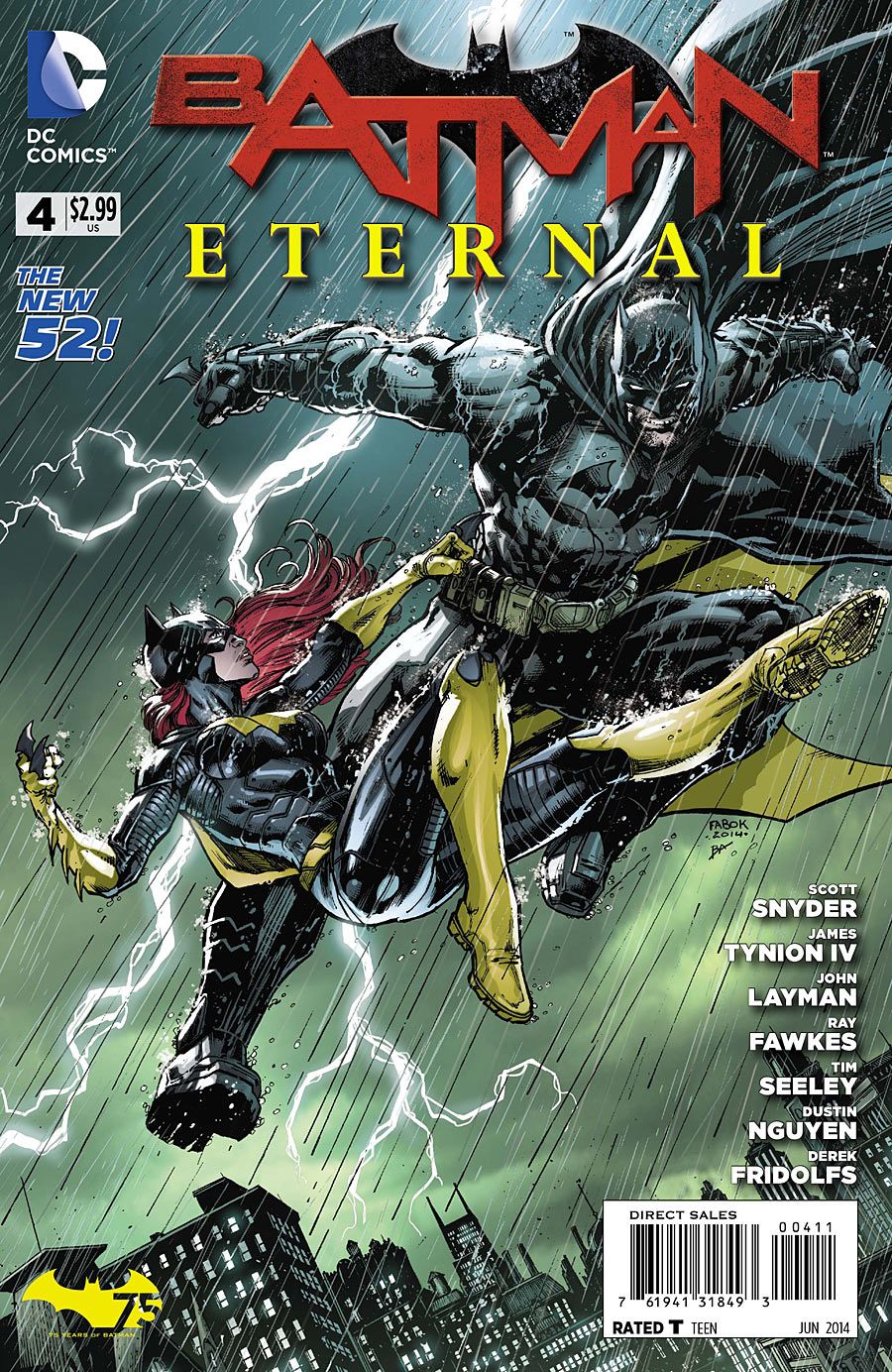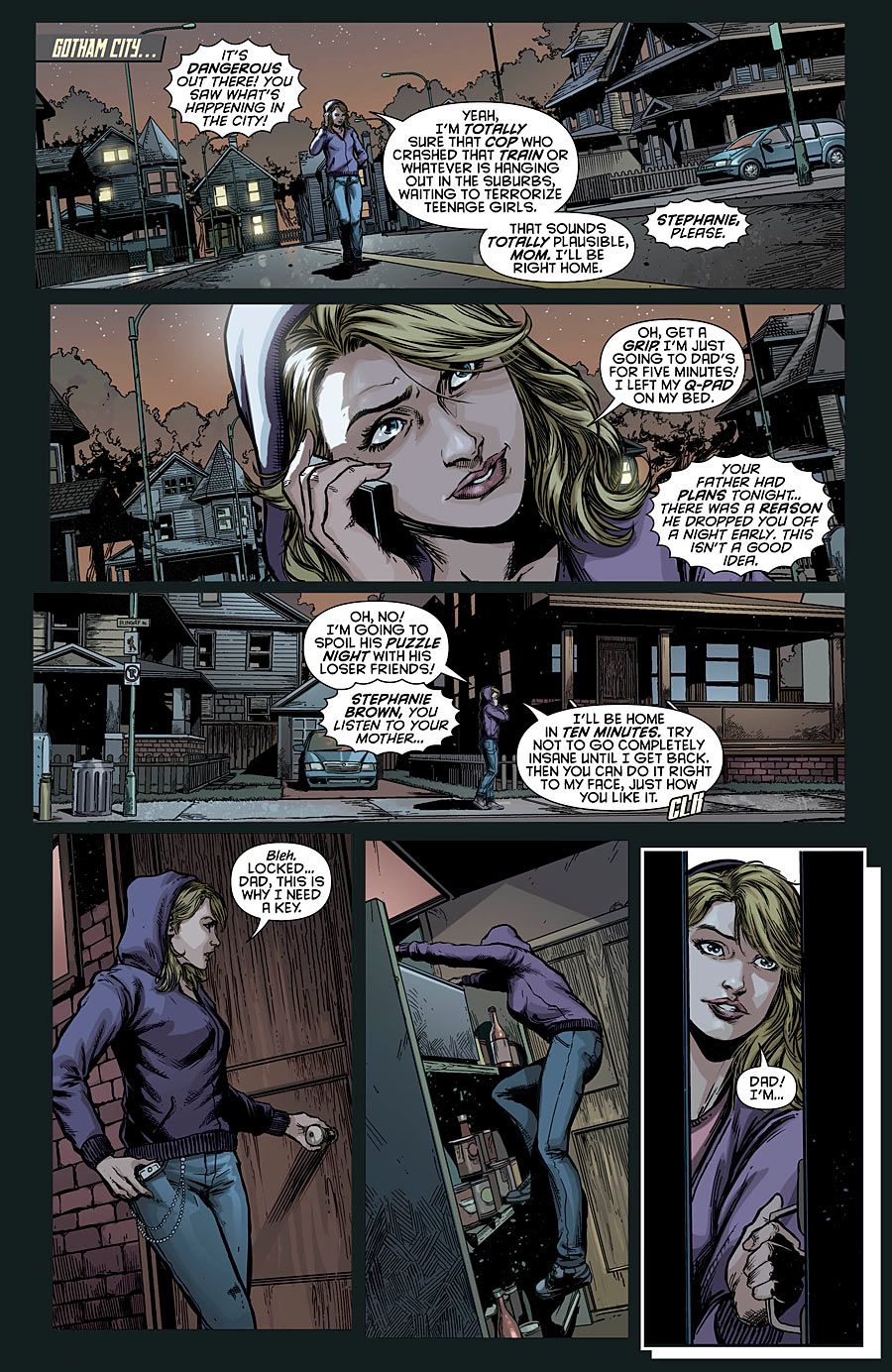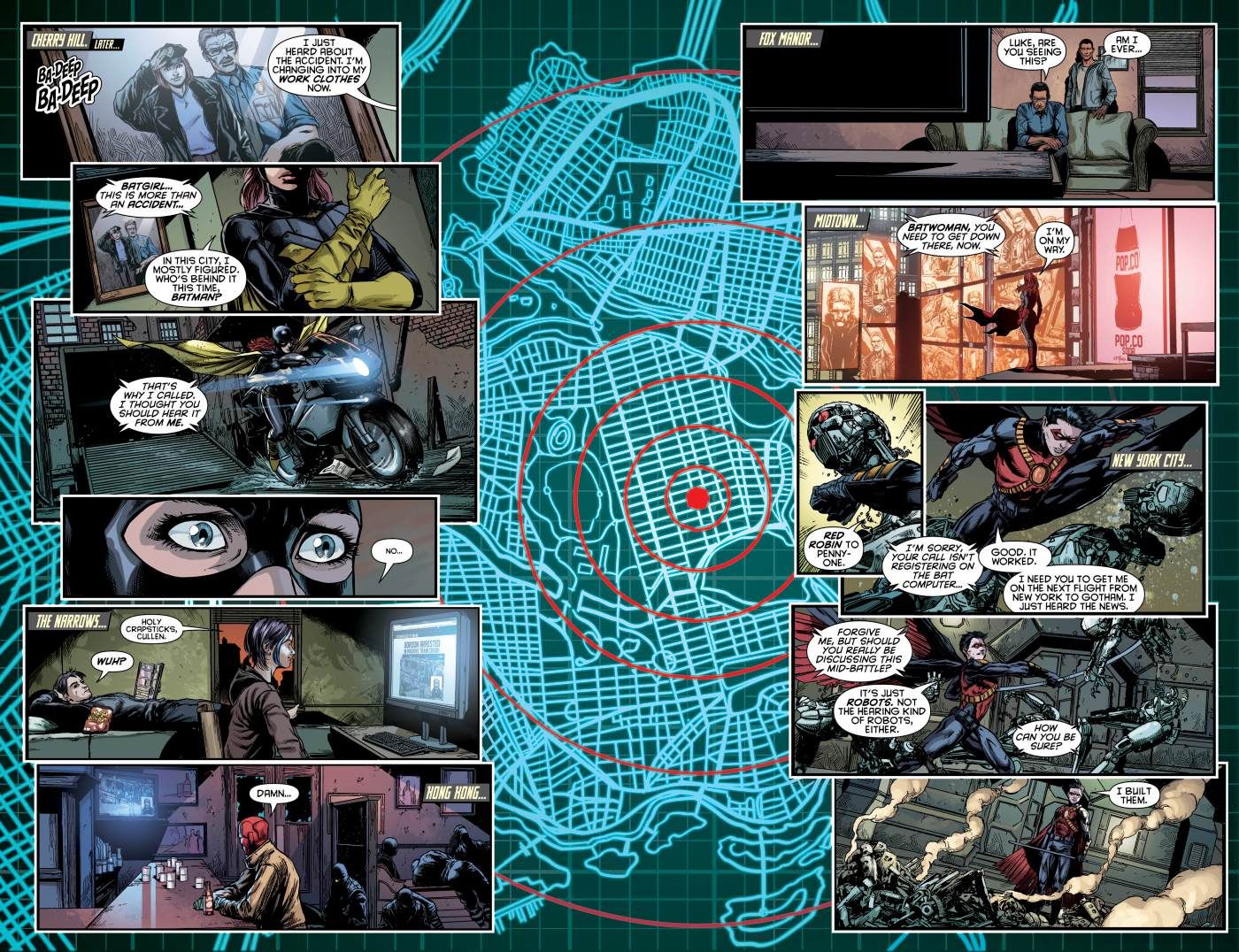Just four issues in, and DC Comics' weekly "Batman Eternal" has already set a major mystery on the table to celebrate the Dark Knight's 75th anniversary.
But beyond the question of who set up James Gordon for a fall, writers Scott Snyder, Tim Seeley and James Tynion IV, alongside series regular artists Jason Fabok and Dustin Nguyen, promise a lot more in the year ahead. Multiple genres, massive status quo changes and new characters galore are all in the offing for what "Eternal" will provide fans.
RELATED: Tynion & Seeley Talk "Batman Eternal's" Long Game
CBR News spoke with the "Eternal" masterminds at C2E2, and the quintet of writers opened up on how multiple flavors of Batman will make the series stand apart from the Bat-pack. Our round table discussion explores why the series had to open with a major crime, how Bruce Wayne will be thrown from his element, what they did to design one take on Gotham for scores of Batman artists and more.
CBR News: Gentlemen, one thing that's stood out about the grand plan for "Eternal" is that the series is designed to explore every conceivable genre Batman fits into, so I wanted to go through the various arenas you'll be hitting. The story starts with what is, in many ways, a straight crime/mystery angle. Why was that the natural launching pad for the book?
Scott Snyder: I think the reason we wanted to start that way was because that's Batman's comfort zone. He's the world's greatest detective, so if a case appears that baffles him entirely and takes his best friend off the table, it would be completely destabilizing. We wanted to start in that genre he's most comfortable in -- and then essentially blow it up.
James Tynion IV: That's exactly it. The other thing that stands out is that we're starting from a core -- the place most readers are familiar with as Batman's base essence. That's the crime and noir elements. The whole point of this first section is about turning Gotham against Bruce in a major way, where the city is reasserting itself. It's turning back into what it used to be before there was a Batman. There's a corrupt police commissioner running everything. Meanwhile, Carmine Falcone is coming back to run organized crime in the city again. Everything is shifting on this massive, massive scale to make it a very unstable place for Batman, and that instability will lead into all the other kinds of stories we'll see. Over the next few weeks, we'll see the different threads start playing out towards where they're going to go.
Let's talk about Carmine for a moment. This is a character that's been a formative figure in Batman stories like "Year One," and the Loeb/Sale stories. What about the character made him a fit for "Eternal," and how do you introduce him to fans who may not be familiar with the character's history?
Tynion: I think the biggest piece of that is, we've never seen a present day story with Carmine Falcone. He only ever shows up in stories where Batman is first starting out. It's always one of his first cases, and it's really never the two of them up against each other. Obviously, Batman helped take down the whole Falcone crime family, but in the stories we've seen before, the Roman was never a real Batman nemesis. He was more an emblem of everything that crime was in Gotham City. The idea of taking a symbol that is such a huge piece of the history of Batman, but utilizing it in the present day, that offers us the kind of story that readers have never seen before.
Tim Seeley: The way Scott and James have set this up, Carmine represents what the old way of crime in Gotham was before Batman came along. It's from before these colorful, costumed villains started showing up and having abandoned theme park bases. He was just a guy out for profit. He wanted to make money, live comfortably and keep everyone out of his way. That's the old method of Gotham crime.
Now that the crime story hook for the whole series is set up in the opening three-part arc, I understand you're kind of going into "story pilot" mode for the long-term threads of the story. How does that break out?
Tynion: #4 is an issue written by John Layman that will be focusing a lot on the character in the Bat Family who's obviously most affected by Jim Gordon's situation: Batgirl. This is the issue that will launch her story forward in the series and into a global adventure. From there, Issue #5 is where we dig into Tim Drake and Harper Row and touch on a strange science fiction subplot that will dig its way into the series. Issue #6 is Ray Fawkes' issue, where we pick up with Jim Corrigan -- The Specter -- from #2. We're going to see what his relationship is with Batman and the beginnings of his investigation into what exactly is growing beneath Arkham. Then Tim's issue is #7, and that's where you start to see everything going back to Hell in Gotham.
Seeley: Yeah! That's where you'll start to see how Penguin ties into Falcone. Catwoman is involved. There are a lot of explosions in that issue. [Laughter] Like, a lot of them.
Well, let's talk about that genre you mentioned with the Corrigan issue:supernatural stories. Issue #2 teased the return of Deacon Blackfire, from the '80s Batman series "The Cult." How easy is it to fit elements like that up against the crime angle?
Snyder: I think one of the fun things about having this series be so collaborative is that each of us have genres that we love. A story that's so big, with so many moving parts that will all come together for a crazy crescendo, gives us each a chance to explore those areas of Batman's adaptability. Ray Fawkes is doing a killer job with Batman's really creepy, horrifying supernatural plot that involves the secrets beneath Arkham. It's really going to shake up the mythology.
On the art side, I know one of the goals for the book is to represent the many ways Batman has been drawn over the years while the writers focus on that genre angle. How do you keep a visual consistency while still cutting loose?
Dustin Nguyen: They send me Jason's pages, so I get a lot of time to look a the other stuff. There are a lot of characters we're introducing or reintroducing, so we double check to make sure everyone's on the same page on the look and feel of a certain character. You can draw a character a million different ways, but so long as you know the characteristics of them and their voice, it translates well between artists.
Jason Fabok: You're going to get such a broad range of artists, but they're bringing in some of the best artists possible to work on this book. Every single week, you're going to get a Triple-A book. Nothing is going to be skimped on, and you're going to get your money's worth every week. That excites me as an artist. I drew the first three issues, but I can't wait to read all of the ones between those and what I'm drawing now -- and that's because I'm so hooked into the story that I want to know how it's going to get to the point that I'm drawing in #18 or 21. I think when this thing is collected, it's going to be just an amazing collection of art and story, all fused together. I hope it creates one of the biggest epic Batman tales of all time.
You mention those reintroduced characters, and you drew quite a few faces that are new to the New 52, like Stephanie Brown, Vicki Vale and Jason Bard. When drawing those characters for the first time, did you look to any past interpretations to help guide you?
Seeley: One of the things we talked about with the visuals was, because we knew there'd be so many artists drawing the book, in order to identify normal people without a giant logo in the middle of their chest, we wanted to make simple designs on all of them. Take Falcone. He's got this simple design where you're always seeing the three scars on his face, and the roses. It always makes him clear. We approached it to always boil him down where he could translate to five or six different art styles -- maybe more, by the time the thing is over.
Fabok: And we're all designing things as a team. One guy may take lead on the design, but we're all giving suggestions. "I always thought that guy should have something like this." "Oh, that's a great idea!" It's created a lot of excitement on the artistic side for establishing this world. Dustin came up with a great Spoiler costume that we saw in "Batman" #28. It's exciting to draw that. Then, with guys like Falcone and Bard, there are just so many guys in this book that you don't ever get bored drawing it.
Seeley: That's probably pretty true.
Fabok: Yeah. Sometimes drawing talking heads in a police station can get pretty boring, but when you're drawing all these interesting characters, there are things you can pull out of each of them. No matter who's talking or delivering a speech. There's always something cool to add in there. It's really a dream book to work on.
To wrap, I want everyone to tell me one thing in this book you're excited about that you aren't responsible for. What's the idea you're most jealous of in the book?
Nguyen: There's a scene that Trevor [McCarthy] draws of Corrigan walking through a field of grass or something that's so trippy and out of place. I like that -- to draw a very supernatural character in a very natural environment.
Fabok: I got to draw a scene of the Spectre's shadow on the wall for one shot, so far. I didn't know much about the character, but I looked him up, and now I keep thinking how cool it would be if I get to play with him for real.
Seeley: I honestly can't think of anything to tell you, because it's all spoilers. [Laughter] But some of the Spoiler character subplots with her family are pretty good. John and James wrote most of those, and they're all these cool "normal teenager girl in a supervillain situation" things that are pretty awesome.
Nguyen: Oh, like the part where she died? [Laughter]
Tynion: There are pieces in the second act of the story that are so huge that they're going to rip Gotham City apart. It's the same sort of thing we said about the first issue. There's a single moment coming that changes Gotham forever. In one of Ray's issues, a big thing happens as part of all this, and there are some really big, dramatic status quo shifts all throughout the series.
Snyder: For me, it's the Selina Kyle stuff. I adore her rise to power as the new kingpin of crime in Gotham. The stuff that Tim is doing along with some others is so terrific. That plotline is really rich and interesting.
"Batman Eternal" #4 is on sale today from DC Comics.





